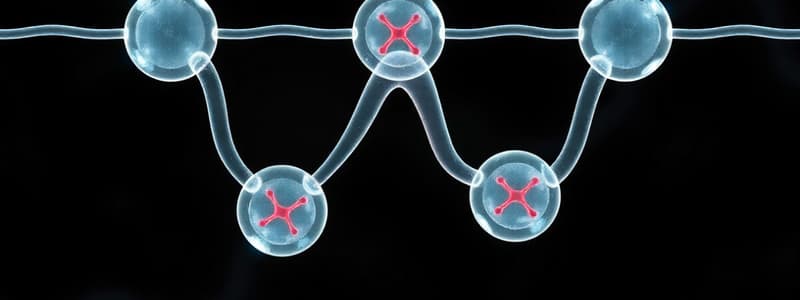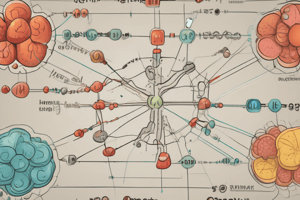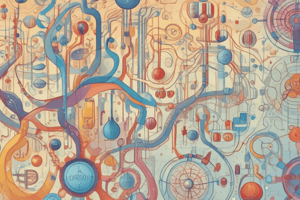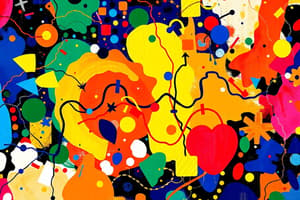Podcast
Questions and Answers
What is the primary function of glycolysis?
What is the primary function of glycolysis?
- Generate NADPH for biosynthesis
- Convert glucose into lactate and pyruvate (correct)
- Break down triacylglycerols
- Synthesize fatty acids
Which pathway primarily occurs in the absence of oxygen during glycolysis?
Which pathway primarily occurs in the absence of oxygen during glycolysis?
- Anaerobic glycolysis (correct)
- Pentose Phosphate Pathway
- Aerobic glycolysis
- Gluconeogenesis
Which of the following is an anabolic pathway?
Which of the following is an anabolic pathway?
- Glycogenesis (correct)
- Glycolysis
- Fatty acid oxidation
- Glycogenolysis
What molecule is formed as a final product of anaerobic glycolysis?
What molecule is formed as a final product of anaerobic glycolysis?
Which term describes pathways that connect anabolic and catabolic reactions?
Which term describes pathways that connect anabolic and catabolic reactions?
What is the end result of glycolysis with respect to pyruvate production?
What is the end result of glycolysis with respect to pyruvate production?
What role does hexokinase play in the first step of glycolysis?
What role does hexokinase play in the first step of glycolysis?
During glycolysis, which of the following statements about the preparatory phase is true?
During glycolysis, which of the following statements about the preparatory phase is true?
Which molecule is not one of the products formed from fructose 1,6-bisphosphate in glycolysis?
Which molecule is not one of the products formed from fructose 1,6-bisphosphate in glycolysis?
Which statement accurately describes the outcome of the second phase of glycolysis?
Which statement accurately describes the outcome of the second phase of glycolysis?
Which step in glycolysis is irreversible and requires a specific enzyme for conversion?
Which step in glycolysis is irreversible and requires a specific enzyme for conversion?
Which enzyme is responsible for the conversion of fructose 1,6-bisphosphate in gluconeogenesis?
Which enzyme is responsible for the conversion of fructose 1,6-bisphosphate in gluconeogenesis?
What initiates the activation of phosphorylase in glycogenolysis?
What initiates the activation of phosphorylase in glycogenolysis?
In which part of the cell does glycogenesis primarily occur?
In which part of the cell does glycogenesis primarily occur?
What happens to excess glucose when glycogen storage approaches saturation?
What happens to excess glucose when glycogen storage approaches saturation?
What is the main type of bond broken by phosphorylase during glycogenolysis?
What is the main type of bond broken by phosphorylase during glycogenolysis?
Which hormone enhances the formation of cAMP leading to the activation of phosphorylase?
Which hormone enhances the formation of cAMP leading to the activation of phosphorylase?
What is the main pathway for the synthesis of glucose from lactate or pyruvate?
What is the main pathway for the synthesis of glucose from lactate or pyruvate?
What is the role of Isocitrate Dehydrogenase in the TCA cycle?
What is the role of Isocitrate Dehydrogenase in the TCA cycle?
Which cofactors are required by the enzyme alpha-ketoglutarate Dehydrogenase?
Which cofactors are required by the enzyme alpha-ketoglutarate Dehydrogenase?
What is produced during the oxidation of succinate in the TCA cycle?
What is produced during the oxidation of succinate in the TCA cycle?
What happens to oxaloacetate during the TCA cycle?
What happens to oxaloacetate during the TCA cycle?
How much total ATP is produced for each acetyl Co-A that enters the TCA cycle?
How much total ATP is produced for each acetyl Co-A that enters the TCA cycle?
What is the main product of the reaction catalyzed by succinate thiokinase?
What is the main product of the reaction catalyzed by succinate thiokinase?
What is a primary function of acetyl-CoA in the TCA cycle?
What is a primary function of acetyl-CoA in the TCA cycle?
What role does pyruvate carboxylation play in the TCA cycle?
What role does pyruvate carboxylation play in the TCA cycle?
What is the primary purpose of the TCA cycle in cellular metabolism?
What is the primary purpose of the TCA cycle in cellular metabolism?
Where do the reactions of the TCA cycle primarily occur within the cell?
Where do the reactions of the TCA cycle primarily occur within the cell?
Which enzyme catalyzes the conversion of pyruvate to acetyl-CoA in the TCA cycle?
Which enzyme catalyzes the conversion of pyruvate to acetyl-CoA in the TCA cycle?
What compound does oxaloacetate combine with to initiate the TCA cycle?
What compound does oxaloacetate combine with to initiate the TCA cycle?
Which coenzyme is NOT required by pyruvate dehydrogenase?
Which coenzyme is NOT required by pyruvate dehydrogenase?
What is a significant outcome of the TCA cycle in terms of amino acids?
What is a significant outcome of the TCA cycle in terms of amino acids?
How is the formation of isocitrate from citrate primarily achieved?
How is the formation of isocitrate from citrate primarily achieved?
Which compound is produced during the oxidative decarboxylation of isocitrate?
Which compound is produced during the oxidative decarboxylation of isocitrate?
What role does the TCA cycle play in amino acid synthesis?
What role does the TCA cycle play in amino acid synthesis?
Which complex in the electron transport chain is responsible for ATP synthesis?
Which complex in the electron transport chain is responsible for ATP synthesis?
What is the primary function of NADH and FADH2 in cellular respiration?
What is the primary function of NADH and FADH2 in cellular respiration?
What happens to the energy of electrons as they travel through the electron transport chain?
What happens to the energy of electrons as they travel through the electron transport chain?
Which of the following correctly describes the process of oxidative phosphorylation?
Which of the following correctly describes the process of oxidative phosphorylation?
How many ATP molecules are generated from one molecule of glucose through complete oxidation?
How many ATP molecules are generated from one molecule of glucose through complete oxidation?
What is the main function of triacylglycerol in living organisms?
What is the main function of triacylglycerol in living organisms?
Which molecule has the strongest reducing ability in the context of electron transport?
Which molecule has the strongest reducing ability in the context of electron transport?
Flashcards
Glycolysis
Glycolysis
The process of breaking down glucose into pyruvate or lactate, producing energy in the form of ATP.
Aerobic glycolysis
Aerobic glycolysis
A metabolic pathway that occurs in the presence of oxygen, ultimately producing acetyl-CoA for the TCA cycle.
Anaerobic glycolysis
Anaerobic glycolysis
A metabolic pathway that occurs in the absence of oxygen, yielding lactate as the final product.
Glycolysis Reactions
Glycolysis Reactions
Signup and view all the flashcards
ATP in glycolysis
ATP in glycolysis
Signup and view all the flashcards
What is glycolysis?
What is glycolysis?
Signup and view all the flashcards
What is the preparatory phase of glycolysis?
What is the preparatory phase of glycolysis?
Signup and view all the flashcards
What is the payoff phase of glycolysis?
What is the payoff phase of glycolysis?
Signup and view all the flashcards
What does hexokinase do?
What does hexokinase do?
Signup and view all the flashcards
What does phosphofructokinase (PFK) do?
What does phosphofructokinase (PFK) do?
Signup and view all the flashcards
Pyruvate to PEP Conversion
Pyruvate to PEP Conversion
Signup and view all the flashcards
Fructose 1,6-bisphosphatase Reaction
Fructose 1,6-bisphosphatase Reaction
Signup and view all the flashcards
Glucose 6-Phosphate to Glucose
Glucose 6-Phosphate to Glucose
Signup and view all the flashcards
Glycogen
Glycogen
Signup and view all the flashcards
Glycogenesis
Glycogenesis
Signup and view all the flashcards
Glycogenolysis
Glycogenolysis
Signup and view all the flashcards
Phosphorylase
Phosphorylase
Signup and view all the flashcards
cAMP
cAMP
Signup and view all the flashcards
What is the Citric Acid Cycle?
What is the Citric Acid Cycle?
Signup and view all the flashcards
Where does the TCA cycle take place?
Where does the TCA cycle take place?
Signup and view all the flashcards
What is the main output of the TCA cycle?
What is the main output of the TCA cycle?
Signup and view all the flashcards
How is acetyl-CoA formed?
How is acetyl-CoA formed?
Signup and view all the flashcards
What is the first reaction of the TCA cycle?
What is the first reaction of the TCA cycle?
Signup and view all the flashcards
What happens after the formation of citrate?
What happens after the formation of citrate?
Signup and view all the flashcards
What is the third step of the TCA cycle?
What is the third step of the TCA cycle?
Signup and view all the flashcards
What are the other roles of the TCA cycle?
What are the other roles of the TCA cycle?
Signup and view all the flashcards
Electron Transport Chain: Role of NADH & FADH2
Electron Transport Chain: Role of NADH & FADH2
Signup and view all the flashcards
Electron Transport Chain: Components
Electron Transport Chain: Components
Signup and view all the flashcards
Oxidative Phosphorylation
Oxidative Phosphorylation
Signup and view all the flashcards
Proton Motive Force
Proton Motive Force
Signup and view all the flashcards
ATP Synthase
ATP Synthase
Signup and view all the flashcards
ATP Yield from Glucose Oxidation
ATP Yield from Glucose Oxidation
Signup and view all the flashcards
Lipid Metabolism: Breakdown
Lipid Metabolism: Breakdown
Signup and view all the flashcards
Triacylglycerol: Energy Storage
Triacylglycerol: Energy Storage
Signup and view all the flashcards
Isocitrate Dehydrogenase
Isocitrate Dehydrogenase
Signup and view all the flashcards
Rate-limiting step in TCA: Isocitrate Dehydrogenase regulation
Rate-limiting step in TCA: Isocitrate Dehydrogenase regulation
Signup and view all the flashcards
α-ketoglutarate Dehydrogenase
α-ketoglutarate Dehydrogenase
Signup and view all the flashcards
Succinate Thiokinase
Succinate Thiokinase
Signup and view all the flashcards
Succinate Dehydrogenase
Succinate Dehydrogenase
Signup and view all the flashcards
Fumarase
Fumarase
Signup and view all the flashcards
Malate Dehydrogenase
Malate Dehydrogenase
Signup and view all the flashcards
The role of the TCA cycle - energy production and biosynthesis
The role of the TCA cycle - energy production and biosynthesis
Signup and view all the flashcards
Study Notes
Metabolism Overview
- Metabolism is the fate of dietary components
- Metabolic pathways include:
- Anabolic pathways: Synthesis of compounds (require energy)
- Catabolic pathways: Breakdown of molecules (produce energy)
- Amphibolic pathways: Connect anabolic and catabolic reactions
- Glucose is central to many biological processes
- Glycogen formation
- Ribose source for DNA and NADPH
- Pyruvate (amino acid and acetyl CoA precursor)
- Triose phosphate (glycerol formation) and triacyl glycerol formation
Glycolysis
- Aerobic glycolysis: Occurs in the presence of oxygen, leading to acetyl CoA and the TCA cycle
- Anaerobic glycolysis: Occurs in the absence of oxygen, resulting in lactic acid formation
- Definition: A sequence of reactions converting glucose to lactate and pyruvate, creating ATP
- Site: Cytosolic fraction of the cell
- End result: Energy production and intermediate production for other biosynthetic pathways
- Steps 1-10: Detailed description of each step, including enzymes involved and products/substances consumed
Pentose Phosphate Pathway (PPP)
- Location: Cytoplasm of cells
- Purpose:
- Oxidative reactions produce NADPH and ribose-5-phosphate.
- Provides pentoses (ribose 5-phosphate) for nucleotide synthesis.
- Important in cells synthesizing lipids and steroids
- G-6-PD deficiency: A genetic disorder, reducing NADPH production in red blood cells, leading to oxidative stress.
Gluconeogenesis, Glycogenesis, and Glycogenolysis
- Gluconeogenesis: The process of producing glucose from non-carbohydrate precursors (e.g., glycerol, lactate, amino acids). This is crucial for brain energy supply.
- Glycogenesis: The process of glycogen synthesis, involving storage of glucose as glycogen.
- Glycogenolysis: The process of glycogen breakdown, releasing glucose into the blood when needed.
- Sources of Glucose:
- Diet
- Glycogenolysis (liver glycogen)
- Gluconeogenesis (amino acids, most important during starvation state)
Substrates Used in Gluconeogenesis
- Glycerol: From triacylglycerol hydrolysis in adipose tissues.
- Lactate: From muscle activity.
- Amino acids: From protein hydrolysis.
Differences between Gluconeogenesis and Glycolysis
- Gluconeogenesis and glycolysis are separate processes, although some reactions are reversible.
- Each process has unique enzymes
- There are 3 steps that cannot be reversed from glycolysis, requiring different enzymes
By-pass steps in Gluconeogenesis
- Bypassing step 10, involves converting pyruvate to phosphoenolpyruvate. This is by the reaction converting pyruvate to oxaloacetate and converting oxaloacetate to phosphoenolpyruvate via the enzyme PEP carboxykinase
- Bypassing steps 1 and 3 in gluconeogenesis, involves fructose-1,6-biphosphatase to remove a phosphate from fructose-1,6-biphosphate and glucose-6-phosphatase to convert glucose-6-phosphate into glucose.
Glycogenesis and Glycogenolysis
- Storage of Glucose: Glycogen is the significant storage form of glucose in liver and muscle cells.
- Glycogenolysis when blood sugar is low: Releases glucose into the blood, especially when energy required.
- Glycogenesis when blood sugar is high: Stores glucose as glycogen.
TCA Cycle
- Location: Mitochondria
- Role: A central pathway for the oxidation of carbohydrates, lipids, and amino acids to produce energy and other molecules. The cycle is an aerobic pathway.
- Products: 3 NADH, 1 FADH2, 1 GTP, and CO2 (with each turn of the cycle)
Oxidative Phosphorylation
- Location: Inner mitochondrial membrane
- Electron Transport:
- NADH/FADH2 generated by glycolysis or the citric acid cycle, transfer electrons to complexes.
- Protons are pumped across the inner mitochondrial membrane generating a proton gradient.
- ATP is synthesized from ADP + Pi using the energy stored in the proton gradient.
Lipid Metabolism
- Importance of lipids: Main energy reserve (triacylglycerol), cell membrane components (phospholipids, cholesterol), and hormone precursors (cholesterol).
- Fatty acid oxidation (β-oxidation): The process of breaking down fatty acids into acetyl-CoA (occurs in the mitochondria). Acetyl-CoA then enters the citric acid cycle for further oxidation.
- Ketone bodies: Produced when acetyl-CoA is produced in excess, utilized for energy in peripheral tissues under certain conditions (low blood sugar).
Studying That Suits You
Use AI to generate personalized quizzes and flashcards to suit your learning preferences.




